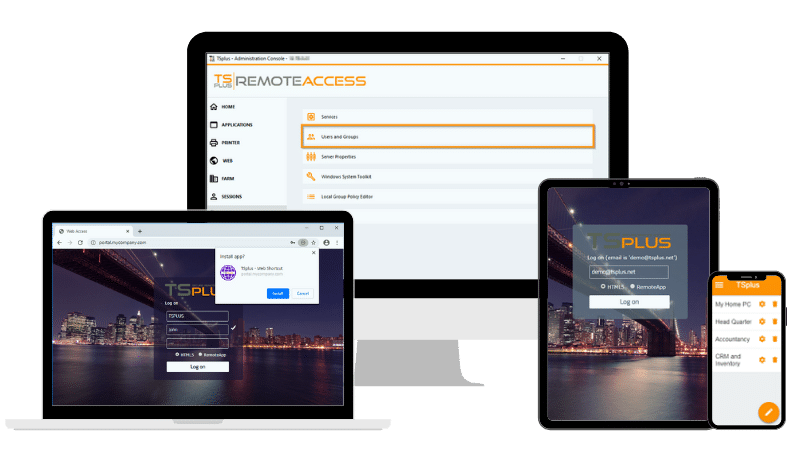)
)
Overview of Google Remote Desktop
Google Remote Desktop is a prominent tool in the arsenal of IT professionals and casual users alike, providing a simple yet powerful means of accessing computers remotely. This section will delve into what makes Google Remote Desktop a valuable tool and how it operates to deliver seamless remote connectivity.
What is Google Remote Desktop?
Google Remote Desktop is a remote access service that allows users to control their computers from a distance using a web browser or a mobile application. Designed for simplicity and speed, it enables quick connections to remote systems without the need for heavy infrastructure or complex setup procedures. This service is particularly useful for users who need to access their home or work computers while traveling or from different locations.
How Does It Work?
The operation of Google Remote Desktop is centered around a user-friendly interface and a straightforward setup process. Here’s how it facilitates remote access:
Access Code Generation
When setting up a remote session, Google Remote Desktop generates a unique access code. This code is a temporary, secure key that the user on the remote computer must provide to establish a connection.
Secure Connection Establishment
The access code is used to create a direct and secure link between the two computers. This connection is protected with industry-standard encryption protocols, ensuring that all transmitted data remains private and inaccessible to unauthorized users.
Session Management
Once connected, the remote user can fully control the desktop, open and manage files, run applications, and perform other tasks as if they were physically present at the machine. The service is designed to minimize latency and provide a responsive experience, even over slower internet connections.
By leveraging a combination of ease of use, robust security measures, and rapid connectivity, Google Remote Desktop provides an efficient solution for remote access needs. This foundational understanding sets the stage for exploring more detailed functionalities and the practical applications of this tool in various IT scenarios.
Key Features of Google Remote Desktop
Google Remote Desktop offers a variety of features that make it a compelling choice for individuals and organizations needing efficient and straightforward remote access solutions. This section explores the key characteristics that define its utility and appeal.
Broad Compatibility
Support Across Multiple Platforms
Google Remote Desktop is compatible with various operating systems including Windows, macOS, Linux, and Chrome OS, enabling users to access their computers from almost any other device. This widespread compatibility ensures that IT professionals and general users alike can maintain productivity regardless of their primary operating system.
Device Flexibility
The service can be accessed through both a web browser and a mobile app available on Android and iOS, providing flexibility for users to control their desktops from smartphones and tablets, not just other computers. This adaptability makes it exceptionally useful for those constantly on the move or those who need to quickly resolve issues without full computer access.
User-Friendly Interface
Intuitive Design
The interface of Google Remote Desktop is designed with simplicity in mind, making it accessible even to those with minimal technical expertise. Its straightforward layout allows users to start remote sessions quickly without navigating complex settings, making the experience seamless and hassle-free.
Quick Setup
Setting up Google Remote Desktop involves very few steps: installing the browser extension or mobile app and entering a unique access code to connect. This simplicity is a significant advantage for users looking for a no-fuss approach to remote desktop access.
Cost-Effectiveness
Free of Charge
One of the most significant advantages of Google Remote Desktop is that it is available free of cost. This makes it an ideal solution for individuals, small businesses, and organizations looking to minimize IT expenditures while still benefiting from remote access capabilities.
By leveraging these features, Google Remote Desktop not only provides essential remote access functionality but also ensures a user-friendly and inclusive experience across multiple platforms and devices. This makes it a preferred tool for many users worldwide, offering both versatility and affordability in remote computing.
Practical Uses in IT
Google Remote Desktop is a crucial tool in the toolkit of IT professionals, serving multiple roles from network management to providing timely technical support. This section highlights the diverse applications of Google Remote Desktop in the IT sector, showcasing its versatility and impact on operational efficiency.
Network Management
Centralized Control
IT administrators can use Google Remote Desktop to monitor and manage networked computers centrally. This capability is vital for maintaining system integrity, performing updates, and managing software installations across multiple machines without needing physical presence at each site.
Real-Time Monitoring and Troubleshooting
With real-time access to any system within the network, IT staff can quickly identify and resolve issues as they arise, minimizing downtime and improving system reliability.
Remote Support and Maintenance
Immediate Technical Assistance
Google Remote Desktop enables IT professionals to provide immediate assistance to users experiencing technical difficulties, regardless of geographic location. This rapid response capability is essential for maintaining high levels of user satisfaction and productivity.
Routine System Maintenance
Performing routine maintenance tasks, such as software updates, security patches, and system checks, can be done remotely, ensuring that all systems are up-to-date and running efficiently without disrupting the user's workflow.
Enhancing Productivity and Responsiveness
Streamlined Operations
By allowing remote access, Google Remote Desktop helps streamline operations, reducing the need for travel and allowing IT staff to address multiple issues across different locations swiftly.
This section demonstrates how Google Remote Desktop supports a broad range of IT functions, from routine maintenance to emergency troubleshooting, enhancing both productivity and operational responsiveness for businesses and organizations.
Limitations of Google Remote Desktop
While Google Remote Desktop is highly valued for its accessibility and simplicity, certain limitations affect its utility in more complex IT environments. This section examines the key areas where Google Remote Desktop may fall short for advanced operations and communication needs.
Lack of Advanced Functionality
Limited File Transfer Capabilities
Google Remote Desktop does not offer a built-in mechanism for file transfers between the host and client computers. This limitation can be problematic for IT tasks that require moving large data sets or files securely between machines.
No Remote Printing
The inability to print documents from a remote location to a local printer can hinder workflow efficiency, particularly for businesses that rely on physical document processing as part of their operations.
Communication Challenges
Absence of Integrated Chat Tool
The lack of an integrated chat feature within Google Remote Desktop means that users must rely on third-party communication tools to discuss issues in real-time during a remote session. This can complicate troubleshooting and slow down the support process.
Security and Privacy Concerns
Dependence on Internet Connectivity
Remote desktop services that rely heavily on internet connectivity can expose users to increased security risks, especially on unsecured or public networks. While Google Remote Desktop uses strong encryption, the inherent risks of transmitting sensitive information over the internet remain a concern.
These limitations underscore the need for potential supplementary tools or alternative solutions, especially for businesses requiring more robust capabilities beyond basic remote access. For IT departments looking for comprehensive features, considering enhanced remote desktop solutions might be necessary.
Enhancing Capabilities with TSplus
While Google Remote Desktop covers basic needs, TSplus extends these capabilities substantially. TSplus offers a solution, Remote Access, which inludes enhanced security features, including customizable user permissions and robust data encryption, which are crucial for businesses with stringent IT requirements.
Moreover, TSplus supports comprehensive remote management tools like session recording, seamless file transfer, and remote printing, which are absent in Google Remote Desktop. These additions make TSplus a superior choice for businesses looking for a more robust and scalable remote desktop solution.
Conclusion
Google Remote Desktop offers a straightforward and cost-effective solution for basic remote access needs. However, for IT departments that require more comprehensive features, TSplus provides an advanced alternative that broadens the scope of what remote desktop solutions can do.

TSplus Remote Access Free Trial
Ultimate Citrix/RDS alternative for desktop/app access. Secure, cost-effective, on-premises/cloud














)
)
)